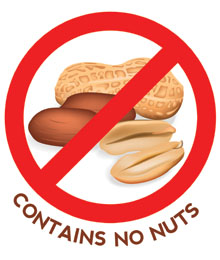Peanut Allergies: Food for Thought
August 4, 2010 by Melissa Sundardas
Filed under Health
 Crunchy, chewy, smooth and even chocolate-coated – peanuts may be a popular food but they can be extremely harmful to the many children who are allergic to them.
Crunchy, chewy, smooth and even chocolate-coated – peanuts may be a popular food but they can be extremely harmful to the many children who are allergic to them.
According to the Centers for Disease Control and Prevention, the number of school-aged children with food allergies has increased almost 20 percent since 1997.
As the summer winds down, parents who have children with peanut allergies may want to be a little more cautious when packing their little girls’ and boys’ back-to-school snacks and medication to relieve allergic reactions.
“Young children spend a large portion of their days in school and our study showed that a significant percentage of serious allergic reactions to food occur in schools,” says Dr. Susan Rudders, MD of Children’s Division of Allergy and Immunology.
A six-year medical chart review of 605 children who visited Boston Hospital’s emergency department for food-related acute allergic reactions, conducted by researchers at the Children’s Hospital Boston and Massachusetts General Hospital, found that a variety of foods caused allergic reactions but that peanuts were the most common.
With 23 percent of reactions stemming from consuming peanuts, Rudders, one of the authors of the study, says it is unknown why peanut allergies are so common and finds it interesting that this allergy is not as common in other regions of the world.
Rudders says what specifically causes someone to develop an allergy is unknown and that allergies are acquired.
“Probably a variety factors are involved, including a person’s genes, diet, environment, etcetera.”
“An allergic reaction is a specific immune response against an allergen – in this case, the allergen is a food. Allergic reactions can cause a wide range of symptoms – hives, swelling, difficulty breathing, vomiting,” she says.
More than half of the 1,255 children who had visited the emergency department in the study due to allergic reactions had anaphylaxis reactions – the most serious form of allergic reaction – to a food they consumed.
Rudders explains that an anaphylaxis reaction is an allergic reaction that causes the quick start of potentially life-threatening symptoms involving multiple organ systems.
A common treatment for an anaphylaxis reactions is self-injectable epinephrine – also known as an EpiPen.
The Boston study’s aim was to find out how frequently children who visited the emergency room with food-related anaphylaxis received more than one dose of epiphrine. It concluded that 12 percent of children who received epinephrine for food-related anaphylaxis required more than one dose because of reappearing symptoms, either before or after visiting the emergency department.
Rudders says this finding calls for a new recommendation that children at risk for food-related anaphylaxis now carry two doses of epinephrine.
Because parents may not always be able to watch what their children are eating outside of the home, they should take extra care in ensuring that all teachers know about their child’s allergy, that regular visits to allergy doctors are made and that two EpiPens and a sufficient amount of other allergy reaction treating medicines are readily accessible in case of a sudden reaction.
Forty-four percent of the children in the study had a known history of food allergies but still consumed these foods accidentally and were taken to the emergency room because of allergic reactions.










Comments
Feel free to leave a comment...
and oh, if you want a pic to show with your comment, go get a gravatar!